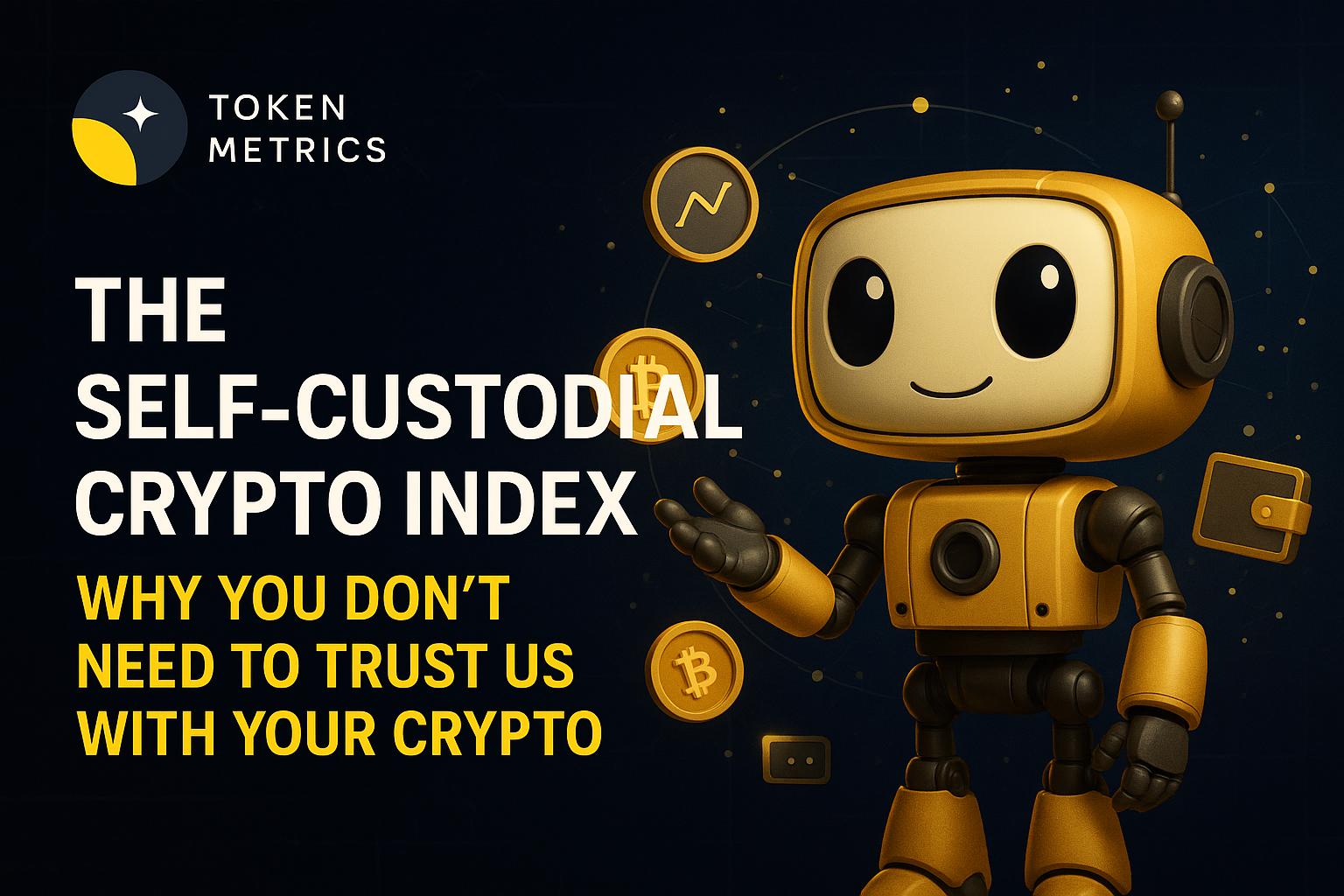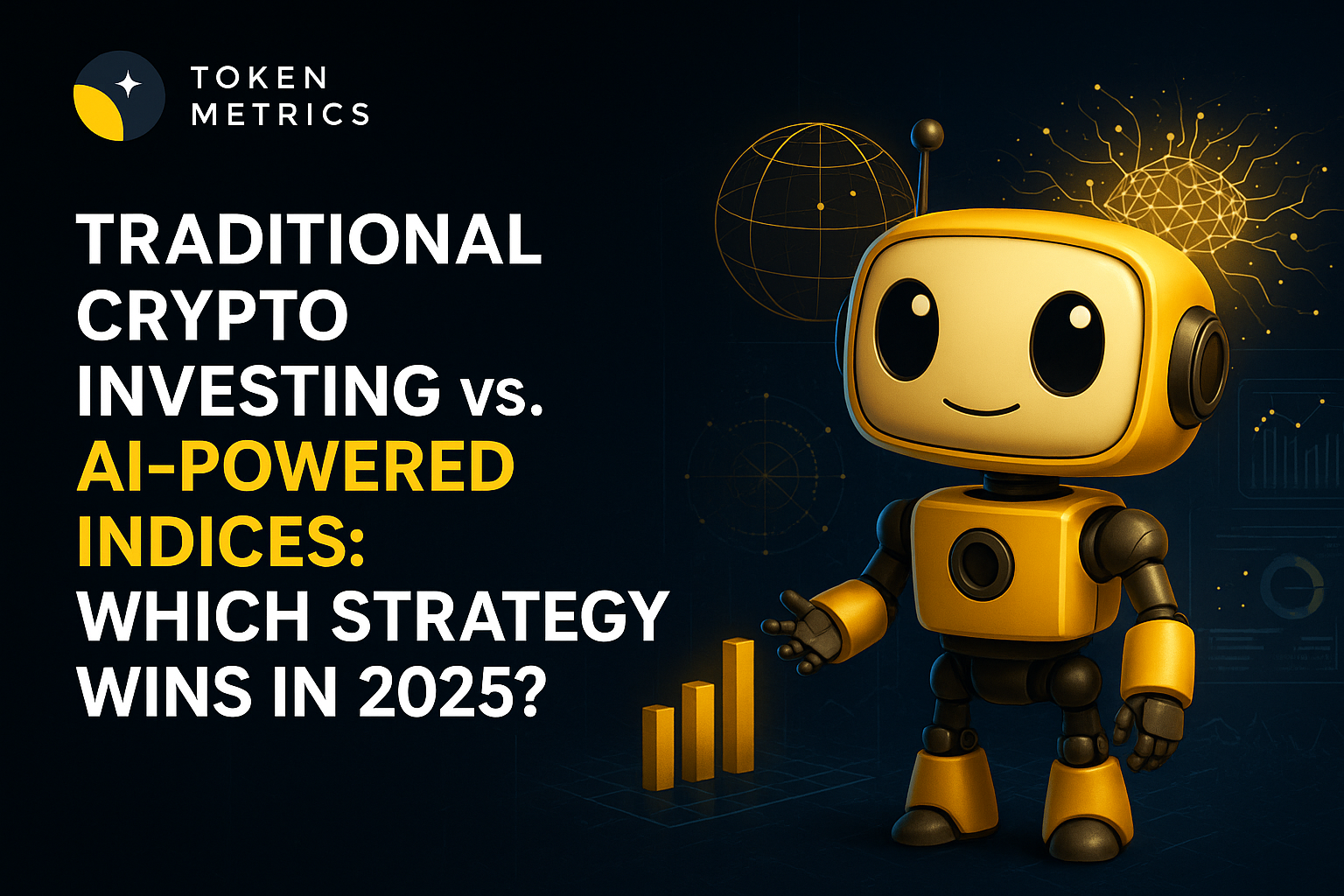
The Self-Custodial Crypto Index: Why You Don't Need to Trust Us With Your Crypto

"Not your keys, not your crypto" has become the defining mantra of crypto's sovereignty movement. Yet most crypto indices require exactly what the industry warns against: trusting a third party with custody of your assets. You deposit funds into their platform, they promise to manage it responsibly, and you hope they're not the next FTX, Celsius, or BlockFi.Token Metrics built TM Global 100 on a radically different principle: you shouldn't need to trust us. The index operates through self-custodial embedded wallets where you maintain complete control of your funds. Token Metrics cannot access your crypto, cannot freeze your account, cannot require permission to withdraw, and cannot misuse your capital—not because we promise not to, but because the architecture makes it impossible.
This isn't marketing language. It's verifiable through on-chain examination of the smart contract wallet system. Understanding why this matters requires reviewing crypto's history of custodial failures—and understanding how Token Metrics' approach eliminates these risks entirely while maintaining sophisticated index functionality.
The Custodial Crisis: When "Trust Us" Fails
Crypto's short history is littered with custodial disasters. Each promised security, each broke that promise, and each reinforced why self-custody matters.
The Hall of Shame: Major Custodial Failures
- Mt. Gox (2014): Once handled 70% of all Bitcoin transactions. Declared bankruptcy after losing 850,000 BTC (~$450M at the time). Users had no recourse—funds simply vanished. Lesson: Size and market dominance don't guarantee security.
- QuadrigaCX (2019): Canadian exchange collapsed after founder's death. $190M in customer funds inaccessible. Revealed funds had been misappropriated for years. Lesson: Single points of failure create catastrophic risk.
- Celsius Network (2022): Promised 18%+ yields on deposits. Filed bankruptcy owing $4.7B to users. Revealed massive mismanagement and risky lending. Users waited years for partial recovery. Lesson: High yields often mask unsustainable business models.
- FTX (2022): Third-largest exchange by volume. Collapsed in 72 hours after revealing $8B hole in balance sheet. Customer deposits illegally used for proprietary trading. Criminal charges against leadership. Lesson: Even "reputable" custodians can commit fraud.
- BlockFi (2022): Lending platform with 650,000+ users. Bankruptcy following exposure to FTX and Three Arrows Capital. Users became unsecured creditors. Lesson: Custodial services create contagion risk across platforms.
The Common Pattern
- Trust establishment: Platform builds reputation through marketing, partnerships, and perceived legitimacy.
- Deposit accumulation: Users transfer custody of assets based on trust.
- Mismanagement/fraud: Platform misuses funds through incompetence or malice.
- Crisis discovery: Problem becomes public, often suddenly.
- Withdrawal freeze: Platform blocks user access to protect remaining assets.
- Bankruptcy: Legal proceedings that recover pennies on the dollar.
Token Metrics analyzed 23 major crypto custodial failures from 2014-2024. Average customer recovery: 31 cents per dollar. Average recovery timeline: 2.7 years. Percentage of cases with criminal charges: 39%. The data is clear: custodial risk isn't theoretical. It's the largest predictable loss vector in crypto investing.
What Self-Custody Actually Means
Self-custody means you—and only you—control the private keys that authorize transactions from your wallet. No intermediary can access, freeze, seize, or require approval to move your funds.
The Key Principles
- Principle 1: Exclusive Control Traditional custody: Provider holds private keys. You request withdrawals. They approve or deny. Self-custody: You hold private keys (or control smart contract wallet). You authorize transactions. No third-party approval required.
- Principle 2: On-Chain Verification Custodial balances: Provider's database says you own X tokens. You trust their accounting. Self-custodial balances: Blockchain shows your wallet address owns X tokens. Publicly verifiable, tamper-proof.
- Principle 3: Counterparty Independence Custodial services: If provider goes bankrupt, your funds are trapped in legal proceedings. Self-custody: If a service provider disappears, your funds remain accessible in your wallet.
- Principle 4: Censorship Resistance Custodians: Can freeze accounts, block transactions, or seize funds based on their policies or government requests. Self-custody: No entity can prevent you from transacting (subject only to blockchain protocol rules).
The Traditional Self-Custody Tradeoffs
Pure self-custody (hardware wallets, MetaMask, etc.) provides maximum security but historically came with significant operational burden:
- Complex setup processes (seed phrases, hardware wallets)
- Manual transaction signing for every action
- No recovery if seed phrase is lost
- Technical knowledge requirements
- Limited functionality (no automated strategies)
These tradeoffs meant most users chose custodial services for convenience—accepting counterparty risk for operational simplicity. Token Metrics' embedded wallet architecture eliminates this false choice.
Token Metrics' Self-Custodial Architecture
TM Global 100 uses embedded smart contract wallets that provide self-custody without traditional complexity. Here's how it works:
Smart Contract Wallets Explained
Traditional crypto wallets are "externally owned accounts" (EOAs)—addresses controlled by a single private key. Lose that key, lose the funds. Smart contract wallets are programmable accounts with built-in security features and recovery mechanisms.
- Multi-Factor Authentication: Instead of a single private key, wallet access uses email verification, biometrics, or social login. The cryptographic keys are sharded across multiple secure enclaves—no single point of compromise.
- Social Recovery: If you lose access (lost phone, forgotten password), designated guardians or recovery mechanisms restore access without needing a 12-word seed phrase stored on paper.
- Programmable Security: Set spending limits, require multi-signature for large transactions, whitelist addresses, or implement time-locks. Security policies impossible with traditional wallets.
- Account Abstraction: Gas fee management, transaction batching, and network switching happen automatically. Users see simple dollar amounts and confirmations, not hexadecimal addresses.
Who Controls What
- You Control: Wallet access (through your authentication), transaction authorization (all buys/sells require your approval), fund withdrawals (move to any address, anytime), recovery mechanisms (designate guardians if desired).
- Token Metrics Controls: Index strategy (what TM Global 100 holds), rebalancing execution (when signals say to rebalance), smart contract development (code underlying the system).
Token Metrics CANNOT:
- Access your wallet without your authentication
- Withdraw your funds to any address
- Freeze your account or block transactions
- Require approval to move your assets
- Seize funds under any circumstances
This separation is enforced by smart contract architecture, not trust. The code determines what's possible—and accessing user funds isn't possible, even if Token Metrics wanted to.
On-Chain Verification
Every TM Global 100 wallet is a publicly visible blockchain address. Using blockchain explorers (Etherscan, etc.), anyone can verify:
- Wallet balance matches what the interface shows
- Transaction history matches logged rebalances
- Funds are actually in user-controlled wallet, not Token Metrics' custody
- Smart contract permissions don't allow Token Metrics withdrawal authority
This transparency means trust becomes optional—you verify rather than trust.
The Practical Reality: How Self-Custody Works Daily
Token Metrics designed TM Global 100's self-custodial experience to be invisible to users while maintaining full sovereignty.
Initial Setup (90 seconds)
- Navigate to TM Global 100 on Token Metrics Indices hub
- Click "Buy Index"
- Create embedded wallet: Provide email or use social login (Google, Apple)
- Set authentication: Biometrics or password
- Fund wallet: Transfer crypto or use on-ramp to purchase
- Confirm purchase: Review TM Global 100 details and approve
Your wallet is created, you control it, and you've bought the index—all while maintaining self-custody.
Ongoing Operations (Zero Custody Risk)
Weekly Rebalances: Token Metrics' smart contract initiates rebalance based on strategy rules. Transaction occurs within YOUR wallet (not custodial account). You can see the transaction on blockchain explorers. Funds never leave your control—they just recompose from BTC+ETH+... to updated weights.
Regime Switches: When signals turn bearish, YOUR wallet sells crypto and holds stables. When signals turn bullish, YOUR wallet buys crypto from stables. Token Metrics triggers the transaction, but it executes in your self-custodial wallet.
Withdrawals: At any time, withdraw some or all funds to any address. No approval needed from Token Metrics. It’s a standard blockchain transaction—Token Metrics can't block it.
What Happens If Token Metrics Disappears?
Imagine Token Metrics goes bankrupt tomorrow. With custodial services, your funds are trapped. With TM Global 100:
- Your wallet still exists (it's on-chain, independent of Token Metrics)
- Your holdings remain accessible (you can view balances on blockchain explorers)
- You can transfer funds (to any wallet/exchange you choose)
- You can continue holding (the tokens don't disappear)
- You can't access automated rebalancing (that requires Token Metrics' smart contracts), but your capital is 100% safe and accessible.
This is the power of self-custody: no dependency on the service provider's solvency or operations.
Comparison to Custodial Crypto Indices
Token Metrics isn't the only crypto index provider. How does TM Global 100's self-custody compare to alternatives?
Custodial Index Providers
- Typical Structure: Deposit funds to provider's platform. Provider holds crypto in their custody. You own "shares" or "units" representing claim on assets. Withdrawal requires provider approval and processing time.
- Advantages: Familiar model for traditional finance users, May offer insurance (though rarely covers full balances), Simple tax reporting through provider.
- Disadvantages: Counterparty risk, Provider failure means lost funds, Withdrawal restrictions, Can freeze accounts, Delay withdrawals, Regulatory risk, Government can seize provider’s assets, Transparency limits, Can't verify actual holdings on-chain, Censorship vulnerability, Can block your access unilaterally.
Self-Custodial Model
Funds remain in your self-custodial smart contract wallet. You maintain control via private authentication. Token Metrics provides strategy execution, not custody. Withdrawal is immediate—it's already your wallet.
- Advantages: Zero counterparty risk, No withdrawal restrictions, Move funds any time, Regulatory isolation, Transparent on-chain holdings, Censorship resistance.
- Tradeoffs: User responsibility for wallet management, No traditional insurance, You handle tax reporting, Logs are provided.
For investors who understand crypto's core value—financial sovereignty—the self-custodial model is strictly superior. Custodial convenience isn't worth systemic risk.
Trustless by Design
Token Metrics established itself as the premier crypto analytics platform by providing exceptional research to 50,000+ users—building trust through performance, not promises. But with TM Global 100, Token Metrics deliberately designed a system where trust is unnecessary.
Traditional Financial Services
"Trust us to handle your money responsibly. We have reputation, insurance, and regulatory oversight."
Crypto's Original Vision
"Don't trust, verify. Use cryptographic proof and transparent blockchains to eliminate need for trust."
TM Global 100
"We provide excellent research and systematic execution. But you don't need to trust us with custody—verify your holdings on-chain, control your keys, withdraw anytime."
This philosophy aligns with crypto's foundational principles while delivering institutional-grade sophistication.
How Token Metrics Makes Money Without Custody
Traditional indices profit by holding client assets and taking fees. Token Metrics profits differently: Platform Fee: Annual percentage (1.5-2.0%) charged from YOUR holdings in YOUR wallet. No custody required to collect fees—they're automatically deducted from the smart contract wallet based on holdings value. Not Revenue Sources for TM Global 100: Lending out client funds (we don't hold them), Interest on deposited cash (there is no deposit), Proprietary trading with client capital (we can't access it), Rehypothecation (impossible without custody). Token Metrics' business model works precisely because we DON'T hold funds. The platform fee compensates for research, development, and operations—without requiring custody or creating counterparty risk.
The Accountability Structure
Self-custody creates natural accountability:
- Custodial Model: If provider performs poorly, changing is difficult (withdrawal delays, tax events, operational friction). Users stay with mediocre services out of inertia.
- Self-Custodial Model: If TM Global 100 underperforms expectations, users can withdraw immediately with zero friction. Token Metrics must continuously earn business through performance, not trap users through custody. This alignment of incentives produces better outcomes. Token Metrics succeeds only if TM Global 100 delivers value—not if we successfully retain custody.
Security Without Custodial Risk
Self-custody doesn't mean "no security"—it means security without counterparty risk. Token Metrics implements multiple security layers:
- Wallet Security: Multi-Factor Authentication, Encryption, Rate Limiting, Device Fingerprinting, Session Management.
- Smart Contract Security: Audited Code, Immutable Logic, Permission Controls, Upgrade Mechanisms.
- Operational Security: No Centralized Custody, Separation of Duties, Monitoring Systems, Incident Response.
- Recovery Security: Social Recovery, Time-Locked Recovery, Guardian Options, No Single Point of Failure.
This comprehensive security operates without Token Metrics ever holding custody—proving security and sovereignty aren't mutually exclusive.
The Regulatory Advantage
Self-custody provides regulatory benefits beyond security:
- Reduced Compliance Burden: Token Metrics doesn't need custodial licenses or maintain costly compliance infrastructure for holdings we don't control.
- Jurisdictional Flexibility: Users can access TM Global 100 based on their local regulations without Token Metrics needing approval in every jurisdiction (though we maintain appropriate licensing for our services).
- Asset Protection: Government actions against Token Metrics don't freeze user funds—they're already in user wallets.
- Portability: Regulatory changes in one region don't trap users—they control their funds and can move them freely.
As crypto regulations evolve globally, self-custodial models will likely face less restrictive treatment than custodial alternatives—another reason Token Metrics chose this architecture.
Decision Framework: Custodial vs. Self-Custodial Indices
- Choose self-custodial indices (TM Global 100) if: You value financial sovereignty, censorship resistance, want on-chain verification, eliminate counterparty risk, are comfortable with wallet authentication, and desire instant withdrawal.
- Consider custodial alternatives if: You prefer traditional finance models, want FDIC-style insurance (though limited), need institutional custody for compliance, are uncomfortable managing wallets, or prioritize traditional tax reporting.
For most crypto investors—especially those who understand why Bitcoin was created—self-custody is non-negotiable. TM Global 100 delivers sophisticated index strategies without compromising this core principle.
Conclusion: Trust Through Verification, Not Promises
The crypto industry has taught expensive lessons about custodial risk. Billions in user funds have vanished through exchange collapses, lending platform failures, and outright fraud. Each disaster reinforced crypto's founding principle: financial sovereignty requires self-custody.
Token Metrics built TM Global 100 to honor this principle. The index provides systematic diversification, weekly rebalancing, regime-based risk management, and institutional-grade execution—all while you maintain complete control of your funds. Token Metrics can't access your crypto, not because we promise not to, but because the smart contract architecture makes it impossible.
This isn't about not trusting Token Metrics. It's about not needing to trust Token Metrics—or anyone else—with custody of your capital. That's how crypto is supposed to work. You verify holdings on-chain. You control withdrawals. You authorize transactions. Token Metrics provides research, signals, and systematic execution. But your crypto stays yours.
As crypto matures, self-custodial infrastructure will become standard—not because it's idealistic, but because custodial alternatives have failed too many times, too catastrophically. Token Metrics is simply ahead of the curve. Not your keys, not your crypto. TM Global 100: your keys, your crypto.

.svg)

Create Your Free Token Metrics Account

.png)




%201.svg)
%201.svg)


%201.svg)










.svg)




.png)